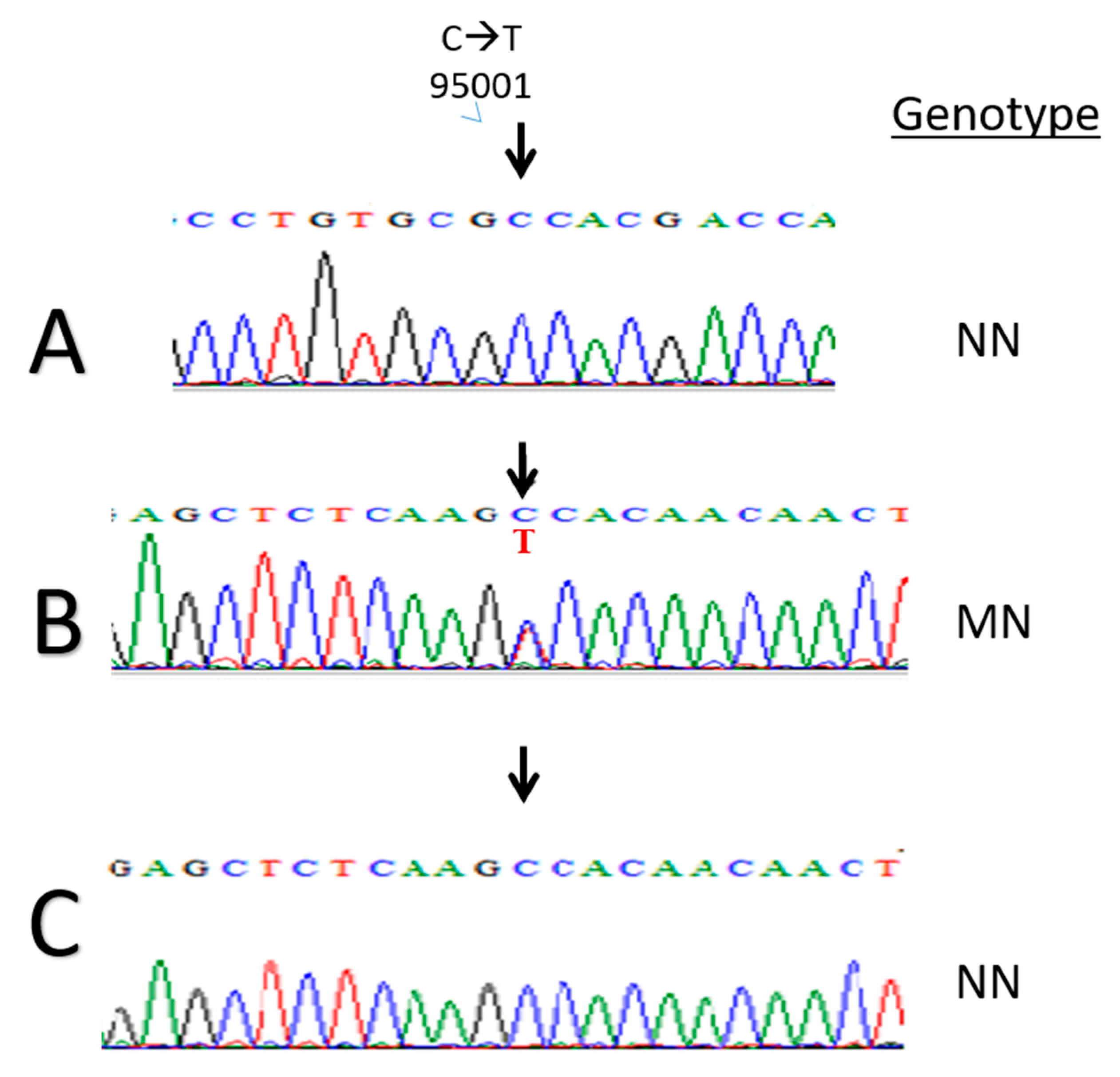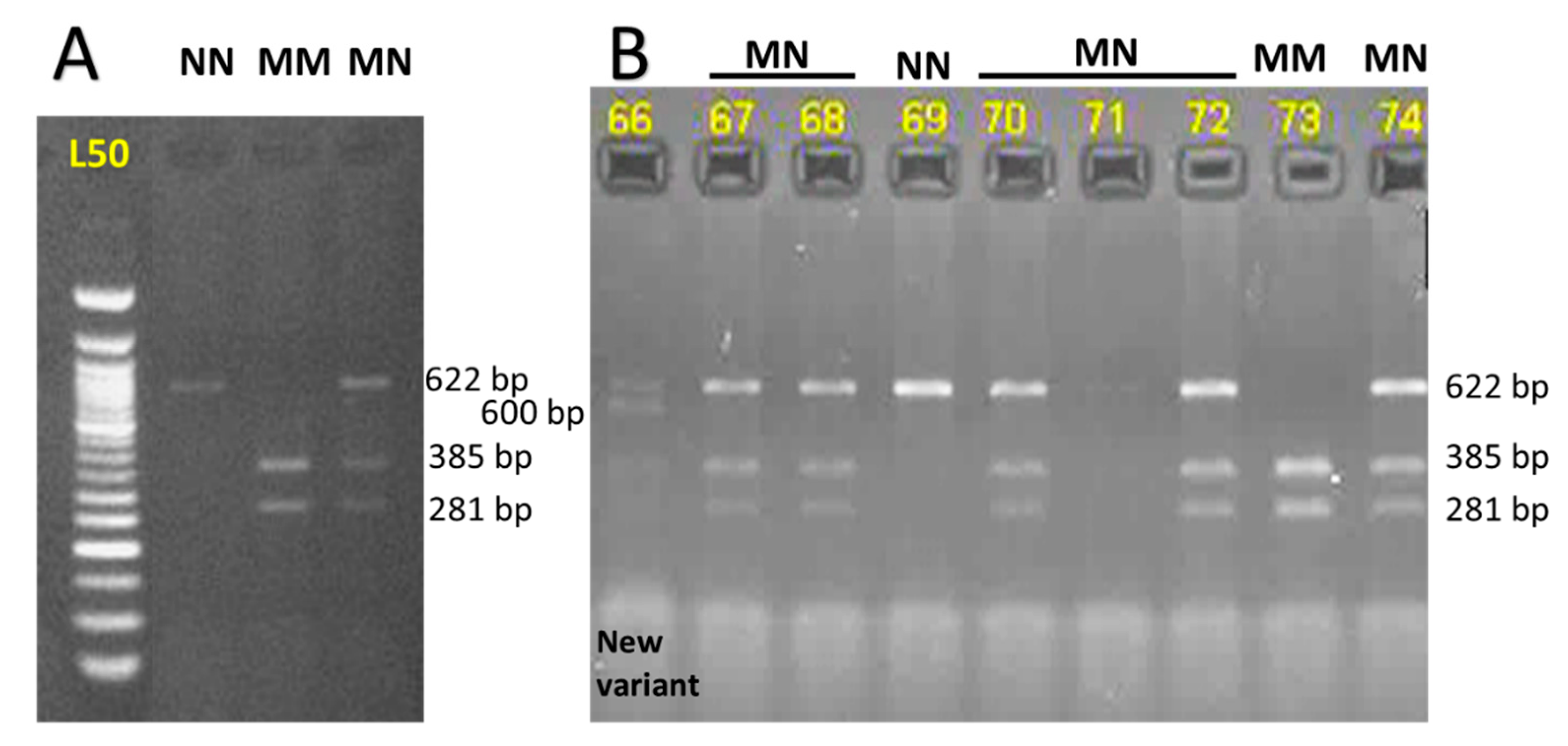Relationships between Hha1 Calpastatin Gene Polymorphism, Growth Performance, and Meat Characteristics of Awassi Sheep
Simple Summary
Abstract
1. Introduction
2. Materials and Methods
2.1. Genotyping and PCR Analysis
2.2. Fattening Trial and Meat Evaluation
2.3. Statistical Analysis
3. Results and Discussions
3.1. Genotyping of Awassi Ram Lambs for the CAST Gene
3.2. Evaluation of Awassi Fattening Response to Various Genotypes of the CAST Gene
4. Conclusion
Author Contributions
Funding
Acknowledgments
Conflicts of Interest
References
- Jawasreh, K.; Khasawneh, A. Studies of some economic characteristic on Awassi lambs in Jordan. Egypt. J. Sheep Goat Sci. 2007, 2, 101–110. [Google Scholar]
- Abi, S.; Darwish, W.; Aad, P.; Sleiman, F.; Kallassy, N.; Aad, Y. Effect of adaptation and heat stress on reproductive performances of fat-tail Awassi rams in eastern Mediterranean. Leban. Sci. J. 2011, 31–44. [Google Scholar]
- Andersson, L. Genetic dissection of phenotypic diversity in farm animals. Nat. Rev. Genet. 2001, 2, 130–138. [Google Scholar] [CrossRef] [PubMed]
- Dekkers, J.C.; Hospital, F. Multifactorial genetics: The use of molecular genetics in the improvement of agricultural populations. Nat. Rev. Genet. 2002, 3, 22. [Google Scholar] [CrossRef] [PubMed]
- Schenkel, F.; Miller, S.; Jiang, Z.; Mandell, I.; Ye, X.; Li, H.; Wilton, J. Association of a single nucleotide polymorphism in the calpastatin gene with carcass and meat quality traits of beef cattle. J. Anim. Sci. 2006, 84, 291–299. [Google Scholar] [CrossRef] [PubMed]
- Zareian Jahromi, E.; Ranjbari, M.; Khaleghizadeh, S.; Ahrari, S.; Ahrari, I.; Ghavipisheh, M. Allelic Polymorphism of Calpastatin Gene (CAST) in Khalkhali Goats: A Possible Marker for Meat Tenderness. Iran. J. Appl. Anim. Sci. 2015, 5, 605–909. [Google Scholar]
- Jawasreh, K.; Amareen, A.A.; Aad, P. Effect and Interaction of beta-Lactoglobulin, Kappa Casein, and Prolactin Genes on Milk Production and Composition of Awassi Sheep. Animals 2019, 9, 382. [Google Scholar] [CrossRef] [PubMed]
- Jawasreh, K.I.; Jadallah, R.; Al-Amareen, A.; Abdullah, A.Y.; Al-Qaisi, A.; Alrawashdeh, I.M.; Al-Zghoul, M.; Ahamed, M.; Obeidat, B. Association between MspI calpastatin gene polymorphisms, growth performance, and meat characteristics of Awassi sheep. Indian J. Anim. Sci. 2017, 87, 635–639. [Google Scholar]
- National Research Council. Designing Foods: Animal product options in the market place; National Academy Press: Washington, DC, USA, 1985. [Google Scholar]
- Jawasreh, K.I.; Alamareen, A.H.; Obeidat, M.D.; Aad, P.Y. Growth Performance and Meat Characteristics of the First Awassi-Rambouillet Callipyge Backcross. Animals 2019, 9, 517. [Google Scholar] [CrossRef] [PubMed]
- Abdullah, A.; Purchas, R.; Davies, A. Patterns of change with growth for muscularity and other composition characteristics of Southdown rams selected for high and low backfat depth. New Zeal. J. Agr. Res. 1998, 41, 367–376. [Google Scholar] [CrossRef]
- Jawasreh, K.; Al-Amareen, A.; Aad, P. Growth performance and meat characteristics of the first filial Awassi-Rambouillet callipyge ram lambs. Vet. World 2019, 12, 783–788. [Google Scholar] [CrossRef] [PubMed]
- Abdullah, A.Y.; Qudsieh, R.I. Effect of slaughter weight and aging time on the quality of meat from Awassi ram lambs. Meat Sci. 2009, 82, 309–316. [Google Scholar] [CrossRef] [PubMed]
- Sumantri, C.; Diyono, R.; Farajallah, A.; Inounu, I. Polymorphism of calpastatin gene and its effect on body weight of local sheeps. ID. J. Anim. Vet. Sci. 2014, 13, 117–126. [Google Scholar]
- Chung, H.; Hines, H.; Davis, M. Effect of calpain and calpastatin genotypes on growth of Angus Bulls. Ohio State Univ. Ext. Res. Bull. 2001, 181–201. [Google Scholar]
- Yilmaz, O.; Cemal, I.; Karaca, O. Genetic diversity in nine native Turkish sheep breeds based on microsatellite analysis. Anim. Genet. 2014, 45, 604–608. [Google Scholar] [CrossRef]
- Nikmard, M.; Molaee, V.; Eskandarinasab, M.P.; Dinparast Djadid, N.; Vajhi, A.R. Calpastatin polymorphism in Afshari sheep and its possible correlation with growth and carcass traits. J. Appl. Anim. Res. 2012, 40, 346–350. [Google Scholar] [CrossRef]
- Greguła-Kania, M. Effect of calpastatin gene polymorphism on lamb growth and muscling. Ann. Anim. Sci. 2012, 12, 63–72. [Google Scholar] [CrossRef]
- Dagong, M.I.A.; Herman, R.; Sumantri, C.; Noor, R.; Yamin, M. Carcass and physical meat characteristics of thin tail sheep (TTS) based on calpastatin gene (CAST)(Locus intron 5–exon 6) genotypes variation. Jurnal Ilmu Ternak dan Veteriner 2012, 17, 13–24. (In Indonesian) [Google Scholar] [CrossRef]
- Ciobanu, D.C.; Bastiaansen, J.W.; Lonergan, S.M.; Thomsen, H.; Dekkers, J.C.; Plastow, G.S.; Rothschild, M.F. New alleles in calpastatin gene are associated with meat quality traits in pigs. J. Anim. Sci. 2004, 82, 2829–2839. [Google Scholar] [CrossRef]
- Juszczuk-Kubiak, E.; Wyszynska-Koko, J.; Wicinska, K.; Rosochacki, S. A novel polymorphisms in intron 12 of the bovine calpastatin gene. Mol. Biol. Rep. 2008, 35, 29–35. [Google Scholar] [CrossRef]
- Juszczuk-Kubiak, E.; Rosochacki, S.J.; Wiciñska, K. A note on restriction fragment length polymorphism for HhaI in the bovine calpain gene. Anim. Sci. Pap. Rep. 2002, 3, 181–185. [Google Scholar]
- Kurył, J.; Kapelański, W.; Pierzchała, M.; Grajewska, S.; Bocian, M. Preliminary observations on the effect of calpastatin gene (CAST) polymorphism on carcass traits in pigs. Anim. Sci. Pap. Rep. 2003, 21, 87–95. [Google Scholar]


| Parameters | CAST/Hha1 Genotype | p-Value | ||
|---|---|---|---|---|
| MM | MN | NN | ||
| * Initial body weight (kg) | 22.5 ± 2.77 | 24.3 ± 2.40 | 20.3 ± 3.92 | 0.6891 |
| Final body weight (kg) | 40.2 ± 1.68 a | 38.2 ± 1.47 a | 36.9 ± 1.42 b | 0.0456 |
| Fasting body weight (kg) | 39.1 ± 1.60 | 37.7 ± 1.40 | 36.2 ± 2.30 | 0.5850 |
| Average daily gain (kg) | 0.302 ± 0.03 | 0.266 ± 0.03 | 0.245 ± 0.04 | 0.5036 |
| Dry matter intake (kg) | 62.6 ± 6.01 | 63.9 ± 5.20 | 58.6 ± 8.50 | 0.8673 |
| Feed conversion ratio (kg feed/kg gain) | 3.68 ± 0.32 | 4.31 ± 0.28 | 4.55 ± 0.45 | 0.2353 |
| Hot carcass weight (kg) | 18.6 ± 0.92 | 19.4 ± 0.94 | 17.4 ± 1.19 | 0.4628 |
| Cold carcass weight (kg) | 18.2 ± 0.91 | 19.1 ± 0.93 | 16.9 ± 1.18 | 0.4250 |
| Dressing% | 50.7 ± 1.25 | 50.8 ± 1.25 | 48.9 ± 1.61 | 0.3141 |
| Legs (kg) | 5.49 ± 0.61 | 6.43 ± 0.61 | 5.02 ± 0.79 | 0.3605 |
| Loins (kg) | 1.69 ± 0.27 | 1.98 ± 0.27 | 1.72 ± 0.35 | 0.7222 |
| Shoulders and racks (kg) | 7.94 ± 0.89 | 9.15 ± 0.89 | 7.06 ± 1.15 | 0.3677 |
| Fat tail (kg) | 1.76 ± 0.46 | 2.29 ± 0.46 | 1.48 ± 0.59 | 0.5347 |
| Heart weight (kg) | 0.13 ± 0.01 | 0.15 ± 0.01 | 0.13 ± 0.02 | 0.5390 |
| Liver weight (kg) | 0.60 ± 0.06 | 0.62 ± 0.06 | 0.53 ± 0.08 | 0.6478 |
| Lungs and trachea weight (kg) | 0.55 ± 0.06 | 0.53 ± 0.06 | 0.44 ± 0.07 | 0.4877 |
| Spleen weigh (kg) | 0.06 ± 0.01 | 0.07 ± 0.01 | 0.05 ± 0.01 | 0.3874 |
| Kidney weight (kg) | 0.09 ± 0.01 | 0.11 ± 0.01 | 0.11 ± 0.01 | 0.4299 |
| Kidney fat weight (kg) | 0.13 ± 0.03 | 0.19 ± 0.03 | 0.15 ± 0.04 | 0.3939 |
| Mesenteric fat weight (kg) | 0.22 ± 0.07 | 0.38 ± 0.07 | 0.25 ± 0.09 | 0.2990 |
| Testes weight (kg) | 0.19 ± 0.03 | 0.18 ± 0.03 | 0.11 ± 0.04 | 0.3665 |
| Loin (kg) | 0.78 ± 0.13 | 0.96 ± 0.13 | 0.83 ± 0.17 | 0.6094 |
| Longissimus weight (kg) | 0.22 ± 0.03 | 0.26 ± 0.03 | 0.20 ± 0.04 | 0.6033 |
| Leg weight (kg) | 2.78 ± 0.29 | 3.17 ± 0.29 | 2.42 ± 0.38 | 0.3239 |
| Total lean (kg) | 1.60 ± 0.15 | 1.80 ± 0.15 | 1.30 ± 0.20 | 0.2371 |
| Intermuscular fat (kg) | 0.066 ± 0.01 | 0.092 ± 0.01 | 0.066 ± 0.01 | 0.1419 |
| Subcutaneous fat (kg) | 0.39 ± 0.07 | 0.51 ± 0.07 | 0.35 ± 0.09 | 0.3902 |
| Total bone (kg) | 0.57 ± 0.06 | 0.61 ± 0.06 | 0.48 ± 0.08 | 0.4387 |
| Parameters | CAST/Hha1 Genotype | p-Value | ||
|---|---|---|---|---|
| MM | MN | NN | ||
| Tissue depth (mm) | 14.4 ± 1.53 | 18.0 ± 1.53 | 14.6 ± 1.98 | 0.2487 |
| Rib fat depth (mm) | 6.20 ± 1.04 | 8.30 ± 1.04 | 6.50 ± 1.34 | 0.3584 |
| Fat depth (mm) | 4.30 ± 1.00 | 6.20 ± 1.00 | 4.50 ± 1.29 | 0.3952 |
| Fat thickness (mm) | 10.2 ± 1.80 | 13.0 ± 1.80 | 9.5 ± 2.3 | 0.4307 |
| Longissimus area (cm2) | 15.2 ± 1.51 | 16.3 ± 1.51 | 11.8 ± 1.95 | 0.2210 |
| Longissimus width (mm) | 63.6 ± 2.54 a | 66.3 ± 2.54 a | 55.8 ± 3.28 b | 0.0518 |
| Longissimus depth (mm) | 27.8 ± 3.15 | 33.6 ± 3.15 | 24.3 ± 4.07 | 0.2179 |
| Parameters | CAST/Hha1 Genotype | p-Value | ||
|---|---|---|---|---|
| MM | MN | NN | ||
| pH | 5.71 ± 0.02 | 5.75 ± 0.02 | 5.72 ± 0.03 | 0.5932 |
| Cooking loss (%) | 47.2 ± 0.68 | 46.5 ± 0.68 | 47.3 ± 0.88 | 0.6989 |
| Water holding capacity (%) | 38.3 ± 1.69 | 36.9 ± 1.69 | 38.2 ± 2.18 | 0.8171 |
| Shear force (kg/cm2) | 5.21 ± 1.13 | 5.87 ± 1.13 | 5.28 ± 1.46 | 0.9077 |
| Color coordinates | ||||
| Whiteness | 34.08 ± 1.42 | 34.76 ± 1.42 | 37.99 ± 1.84 | 0.2694 |
| Redness | 3.06 ± 0.42 | 3.57 ± 0.42 | 2.19 ± 0.54 | 0.1878 |
| Yellowness | 18.78 ± 0.82 | 17.66 ± 0.82 | 19.64 ± 1.06 | 0.3523 |
© 2019 by the authors. Licensee MDPI, Basel, Switzerland. This article is an open access article distributed under the terms and conditions of the Creative Commons Attribution (CC BY) license (http://creativecommons.org/licenses/by/4.0/).
Share and Cite
Jawasreh, K.I.; Al-Amareen, A.H.; Aad, P.Y. Relationships between Hha1 Calpastatin Gene Polymorphism, Growth Performance, and Meat Characteristics of Awassi Sheep. Animals 2019, 9, 667. https://doi.org/10.3390/ani9090667
Jawasreh KI, Al-Amareen AH, Aad PY. Relationships between Hha1 Calpastatin Gene Polymorphism, Growth Performance, and Meat Characteristics of Awassi Sheep. Animals. 2019; 9(9):667. https://doi.org/10.3390/ani9090667
Chicago/Turabian StyleJawasreh, Khaleel I., Ahmad H. Al-Amareen, and Pauline Y. Aad. 2019. "Relationships between Hha1 Calpastatin Gene Polymorphism, Growth Performance, and Meat Characteristics of Awassi Sheep" Animals 9, no. 9: 667. https://doi.org/10.3390/ani9090667
APA StyleJawasreh, K. I., Al-Amareen, A. H., & Aad, P. Y. (2019). Relationships between Hha1 Calpastatin Gene Polymorphism, Growth Performance, and Meat Characteristics of Awassi Sheep. Animals, 9(9), 667. https://doi.org/10.3390/ani9090667





